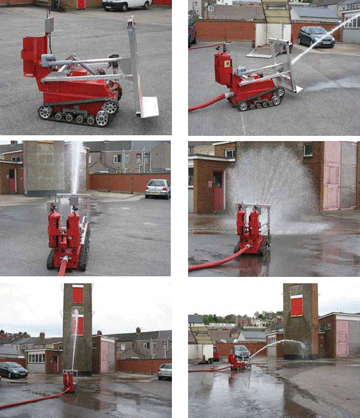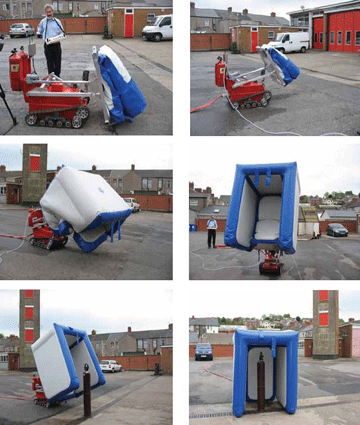Firemote & Cylinder Isolation Unit / Remote Deployment & Firefighting
 A joint venture between Cintec™ International Ltd and Ryland Engineering has produced a complimentary versatile combination of stand-alone fire fighting robot coupled with a blast mitigation product known as Waterwall.
A joint venture between Cintec™ International Ltd and Ryland Engineering has produced a complimentary versatile combination of stand-alone fire fighting robot coupled with a blast mitigation product known as Waterwall.
The partnership has produced a robotic vehicle that is small enough to enter narrow entrances such as domestic or small workshop doorways, climb steps and thresholds and manoeuvre around obstacles. With the aid of a camera and/or thermal imager the robot can attack the seat of the fire using an articulated arm that can be elevated and traversed remotely. The water connection is at the rear of the robot and it passes through the body of the robot into the articulated arm at the front. The arm has an electronically controlled valve attached to the end of the arm that can give a variety of spray effects to fight the fire.
 Once the fire is under control, the robot is able to search the area for any dangerous acetylene gas bottles that may have been in or adjacent to the fire or any other industrial hazards. Should an acetylene bottle be discovered, the robot identifies the site and position and notes any obstacles that may obstruct clear access to the cylinder. It then returns to the controller to have a quick attachment jig mounted on the front and main body of the robot. Should it be necessary for the robot to return to the cylinder to clear a access area around the cylinder it will be able to using the jig as a plough. When a clear area has been formed, the robot returns to the controller for the Waterwall cylinder isolation unit. The Waterwall cylinder isolation unit has been tested to destruction at the Royal College of Science testing range at COTEC West Lavington, Salisbury Plain, England. This test report is available on request.
Once the fire is under control, the robot is able to search the area for any dangerous acetylene gas bottles that may have been in or adjacent to the fire or any other industrial hazards. Should an acetylene bottle be discovered, the robot identifies the site and position and notes any obstacles that may obstruct clear access to the cylinder. It then returns to the controller to have a quick attachment jig mounted on the front and main body of the robot. Should it be necessary for the robot to return to the cylinder to clear a access area around the cylinder it will be able to using the jig as a plough. When a clear area has been formed, the robot returns to the controller for the Waterwall cylinder isolation unit. The Waterwall cylinder isolation unit has been tested to destruction at the Royal College of Science testing range at COTEC West Lavington, Salisbury Plain, England. This test report is available on request.
The Waterwall is attached un-inflated to the front of the robot with water hose and air connections to the rear of the unit.
 The controller guides the robot into the building and directly in front of the cylinder. Air is pumped into the isolator. The isolation unit is packed in such a way that it inflates to the correct profile and attitude that is needed to position it around the cylinder. When it forms its final shape the robot positions the unit to surround the cylinder on three sides. Usually, gas cylinders are attached to a wall or stand and an added door is not required. However, this can be provided if needed.
The controller guides the robot into the building and directly in front of the cylinder. Air is pumped into the isolator. The isolation unit is packed in such a way that it inflates to the correct profile and attitude that is needed to position it around the cylinder. When it forms its final shape the robot positions the unit to surround the cylinder on three sides. Usually, gas cylinders are attached to a wall or stand and an added door is not required. However, this can be provided if needed.
When the cylinder is totally encapsulated and the Waterwall is in its final position, water is pumped in displacing all the air in the bag. This is controlled using pressure relief valves positioned at the very top of the bag. When finally inflated the Waterwall surrounding the gas cylinder with 3900 litres or 1030 US gals of water which reduces the stand-off safe distance to less than five metres. The robot is then remotely detached from the unit and can continue to be deployed.


